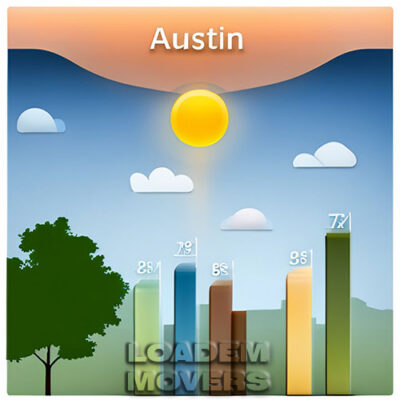Moving to Austin: A Comprehensive Guide
Austin, Texas is a thriving city with a unique culture and a lot to offer. From its live music scene and outdoor recreation to its growing tech industry and vibrant food scene, there’s something for everyone in Austin. However, moving to Austin can be a daunting experience, especially for those who are unfamiliar with the area. Here’s a comprehensive guide to help you make a smooth transition to your new home in the capital of Texas.
moving to Austin can be a daunting experience, especially for those who are unfamiliar with the area
Neighbourhoods in Austin 
Austin has a variety of neighbourhoods, each with its own unique character and culture. Some popular neighbourhoods include Downtown, South Congress, and Hyde Park. Make sure to research the different neighbourhoods and find the one that best fits your lifestyle and budget.
Cost of Living 
Austin has a relatively low cost of living compared to other major cities in the United States. However, housing costs have been on the rise in recent years due to the city’s growing population. According to Numbeo, the cost of living in Austin is about 7% lower than the national average.
the cost of living in Austin is about 7% lower than the national average
Weather 
Austin has a humid subtropical climate, with hot summers and mild winters. Summers can be hot and humid, with temperatures reaching up to 100 degrees Fahrenheit, while winters are mild with occasional freezes. Be prepared for all types of weather and invest in the appropriate clothing and gear.
Transportation 
Austin has a variety of transportation options, including buses, light rail, and ride-sharing services like Uber and Lyft. However, if you plan on driving, be prepared for heavy traffic during rush hour and limited parking options in downtown areas.
Job Market 
Austin has a growing job market, with a variety of industries such as technology, healthcare, and government. Some of the top employers in the city include Dell, IBM, and the University of Texas at Austin. Make sure to do your research and find job opportunities that fit your skills and experience.
Schools and Education 
Austin has a variety of excellent public and private schools, as well as several top-ranked universities and colleges such as the University of Texas at Austin and St. Edward’s University. If you have children, make sure to research schools in the area and find one that fits your family’s needs.
Attractions and Entertainment 
from its live music scene and outdoor recreation to its vibrant food scene and popular festivals like South by Southwest
Austin has a wealth of cultural attractions and entertainment options, from its live music scene and outdoor recreation to its vibrant food scene and popular festivals like South by Southwest. Make sure to explore the city and find activities and events that interest you.
Food and Dining 
Austin is known for its diverse food culture, with a variety of restaurants and cuisines from around the world. From BBQ and Tex-Mex to vegetarian and vegan options, there’s something for every taste bud.
Moving Companies 
If you’re planning on moving to Austin, consider hiring a professional moving company to help you with the process. There are many moving companies in the area that offer a variety of services, including packing, transportation, and storage.
Getting Involved in the Community
One of the best ways to make the transition to Austin is to get involved in the local community. Attend local events, join clubs or organizations, or volunteer your time to get to know the city and meet new people.
Finding Your Perfect neighbourhood in Austin
Austin has a variety of neighbourhoods, each with its own unique character and culture. Whether you’re looking for a hip and trendy area or a more family-friendly neighbourhood, there’s something for everyone in Austin. Here are some popular neighbourhoods to consider:
Downtown
Downtown Austin is the heart of the city, known for its vibrant nightlife and cultural attractions like the Texas State Capitol and the Paramount Theatre. The neighbourhood has a variety of high-rise apartments and condos, as well as trendy restaurants and bars.
South Congress
South Congress is a popular neighbourhood located just south of downtown Austin, known for its quirky shops, cafes, and live music venues. The neighbourhood has a variety of housing options, from historic homes to modern apartments.
Hyde Park
Hyde Park is a historic neighbourhood located just north of the University of Texas at Austin, known for its tree-lined streets and bungalow-style homes. The neighbourhood has a variety of parks and green spaces, as well as a variety of local shops and restaurants.
East Austin
East Austin is a diverse and rapidly changing neighbourhood, known for its vibrant street art and multicultural food scene. The neighbourhood has a variety of housing options, from historic homes to modern apartments and condos.
Barton Hills
Barton Hills is a family-friendly neighbourhood located just south of downtown Austin, known for its beautiful parks and green spaces. The neighbourhood has a variety of housing options, from single-family homes to townhouses and apartments.
Finding the Right Schools in Austin
If you have children, finding the right schools is an important factor to consider when moving to Austin. The city has a variety of excellent public and private schools, as well as several top-ranked universities and colleges. Here are some resources to help you find the right schools for your family:
GreatSchools.org
GreatSchools.org is a website that provides ratings and reviews of schools across the United States. The website offers a variety of resources for parents, including school profiles, test scores, and parent reviews.
Austin Independent School District
The Austin Independent School District is the largest school district in the Austin area, with over 81,000 students enrolled in over 130 schools. The district offers a variety of educational programs, including magnet schools, charter schools, and special education programs.
Private Schools
Austin is home to a variety of excellent private schools, including St. Andrew’s Episcopal School, St. Stephen’s Episcopal School, and Regents School of Austin. Private schools offer a variety of educational programs, as well as smaller class sizes and more individualized attention.
Universities and Colleges 
Austin is also home to several top-ranked universities and colleges, including the University of Texas at Austin, St. Edward’s University, and Austin Community College. These institutions offer a variety of undergraduate and graduate programs, as well as research opportunities and community outreach programs.
Navigating Austin’s Transportation Options
Austin has a variety of transportation options, including buses, light rail, and ride-sharing services like Uber and Lyft. However, if you plan on driving, be prepared for heavy traffic during rush hour and limited parking options in downtown areas. Here are some tips for navigating Austin’s transportation system:
Capital Metro
Capital Metro is Austin’s public transportation system, which includes buses and light rail. The system operates throughout the city and surrounding areas, with over 80 routes and more than 3,000 bus stops. You can purchase a MetroCard to pay for your fare, which can be reloaded online or at transit centres.
Taxis and Ride-Sharing Services 
Taxis are widely available in Austin and can be hailed on the street or called through a taxi app. Ride-sharing services like Uber and Lyft are also widely available and can be a convenient option for getting around the city.
Biking 
Austin has a growing biking culture, with a variety of bike lanes and paths throughout the city. B-cycle is a bike-sharing program that offers affordable bike rentals throughout the city.
Walking 
Austin is a great city to explore on foot, with a variety of neighbourhoods and attractions within walking distance of each other. Walking can also be a convenient and healthy way to get around the city.
Finding Employment in Austin 
Austin has a growing job market, with a variety of industries such as technology, healthcare, and government. Some of the top employers in the city include Dell, IBM, and the University of Texas at Austin. Here are some tips for finding employment in Austin:
Job Search Websites 
There are a variety of job search websites that cater specifically to the Austin job market, including Indeed, Monster, and Glassdoor. These websites offer a variety of job listings, as well as resources for resume writing and interviewing.
Networking 
Networking can be an important way to find employment in Austin. Attend industry events, join professional organizations, and connect with others in your field to make valuable connections and learn about job opportunities.
Staffing Agencies
Staffing agencies can be a helpful resource for finding temporary or permanent employment in Austin. These agencies work with a variety of companies and industries, and can help match you with job opportunities that fit your skills and experience.
Freelancing
Freelancing can be a popular way to work in Austin, especially in industries like media, design, and technology. Websites like Upwork and Freelancer offer a variety of freelance job opportunities, as well as resources for managing your freelance career. 
Conclusion
Moving to Austin can be an exciting and rewarding experience, but it’s important to do your research and prepare yourself for what to expect. Consider factors like the cost of living, transportation options, and job market before making the move, and find the neighbourhood that best fits your lifestyle and needs. Once you’ve made the move, make sure to explore the city and get involved in the local community to make the most of your new home.

